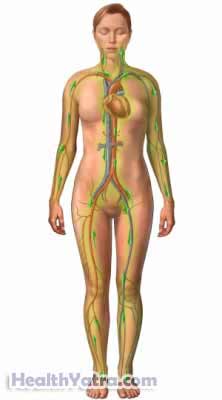परिभाषा
A central line-associated bloodstream infection (CLABSI) occurs when bacteria enters the bloodstream through a central line catheter. A central line catheter is a long, thin tube that is inserted through a vein until it reaches a larger vein close to the heart. It is used to deliver medicine, nutrition, IV fluids, and chemotherapy.

If bacteria start to grow on the central line catheter, they can easily enter the blood and cause a serious infection. This can lead to a condition called sepsis, which occurs when bacteria overwhelm the body. If you suspect you have this condition, call your doctor right away.
का कारण बनता है
Bacteria normally live on the skin. These bacteria will sometimes track along the outside of the catheter. From the catheter, they can get into the bloodstream.
जोखिम कारक
These factors increase your chance of developing a CLABSI:
- बहुत लंबे समय तक कैथेटर रखना
- ऐसा कैथेटर रखना जिस पर रोगाणुरोधी (एक ऐसा पदार्थ जो बैक्टीरिया को मारता है) लेपित न हो
- जांघ की नस में कैथेटर डालना
- सप्ताहांत प्रतिरक्षण प्रणाली उपलब्ध होना
- गहन चिकित्सा इकाई में होना
- शरीर या त्वचा में कहीं और संक्रमण होना
लक्षण
If you have any of these symptoms, do not assume it is due to CLABSI. These symptoms may be caused by other conditions. Tell your doctor if you have any of these:
- बुखार
- Chills
- तेज़ हृदय गति
- कैथेटर स्थल पर लालिमा, सूजन या कोमलता
- Drainage from catheter site
निदान
Your doctor will ask about your symptoms and medical history and perform a physical exam.
परीक्षण शामिल हो सकते हैं निम्नलिखित:
- रक्त परीक्षण और कल्चर-रक्त कोशिकाओं की जांच करने और बैक्टीरिया मौजूद हैं या नहीं इसकी जांच करने के लिए
- संक्रमण की जांच के लिए अन्य कल्चर- मूत्र, थूक और/या त्वचा
- Echocardiogram —to check the heart to see if bacteria have reached the heart valves
उपचार
अपने चिकित्सक के साथ बात के बारे में सबसे अच्छा उपचार योजना के लिए आप. उपचार के विकल्प में निम्न शामिल हैं:
- एंटीबायोटिक्स-एंटीबायोटिक्स ऐसी दवाएं हैं जिनका उपयोग किसी संक्रमण के इलाज के लिए किया जाता है। आपको किस प्रकार का एंटीबायोटिक दिया जाएगा यह इस बात पर निर्भर करता है कि आपके रक्त में कौन सा बैक्टीरिया पाया जाता है।
- Central line care—Often, the central line catheter will need to be removed and replaced by a new catheter.
रोकथाम
अस्पताल में
When you are getting a central line placed, the staff will take the following steps to reduce your risk of infection:
- कैथेटर डालने के लिए सावधानी से एक सुरक्षित स्थान चुनें।
- अपने हाथ अच्छी तरह धोएं या हैंड सैनिटाइज़र का उपयोग करें।
- सर्जिकल गाउन, मास्क, दस्ताने और बालों को ढकने वाला कपड़ा पहनें।
- Clean the area with antiseptic cleanser.
- अपने ऊपर एक स्टेराइल शीट रखें।
After the central line is in place, the staff will:
- कैथेटर को छूने या कैथेटर पर पट्टी बदलने से पहले अपने हाथ अच्छी तरह धो लें और दस्ताने पहन लें।
- कैथेटर के उद्घाटन को साफ करने के लिए एक एंटीसेप्टिक का उपयोग करें।
- कैथेटर के माध्यम से पहुंचाई जाने वाली दवा, तरल पदार्थ या पोषण को संभालते समय सावधानी बरतें।
- Keep the catheter in place only as long as it is needed.
- संक्रमण के लक्षणों के लिए प्रतिदिन कैथेटर और सम्मिलन स्थल की जाँच करें।
- जब पट्टी बदली जा रही हो तो अपने अस्पताल के कमरे में आगंतुकों को अनुमति न दें।
ऐसे भी कदम हैं जो आप संक्रमण के जोखिम को कम करने के लिए उठा सकते हैं:
- संक्रमण को रोकने के लिए कर्मचारियों को हर सावधानी बरतने के लिए कहें।
- यदि पट्टी बदलने की आवश्यकता हो या वह स्थान लाल हो या घाव हो तो तुरंत स्टाफ को बताएं।
- अपने अस्पताल कक्ष में प्रवेश करने वाले प्रत्येक व्यक्ति को हाथ धोने के लिए कहें। आगंतुकों को अपने कैथेटर को छूने की अनुमति न दें।
घर पर
- Follow all instructions concerning your central line.
- जानें कि अपने कैथेटर की देखभाल कैसे करें। इन सामान्य दिशानिर्देशों का पालन करें:
- Follow specific instructions about showering and bathing.
- कैथेटर को छूने से पहले, अपने हाथ धोएं या हैंड सैनिटाइज़र का उपयोग करें। क्षेत्र को छूते समय दस्ताने पहनें।
- Change bandages as directed.
- कैथेटर कैप को एंटीसेप्टिक से धोएं।
- किसी को भी कैथेटर या ट्यूब को छूने की अनुमति न दें।
- Check the insertion site daily for signs of infection (eg, redness and swelling).
- Call your doctor if you think you have an infection (eg, fever, chills).
